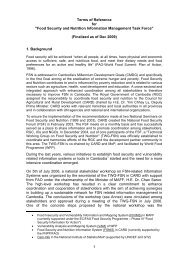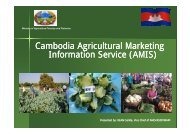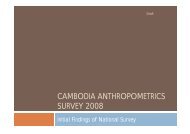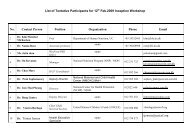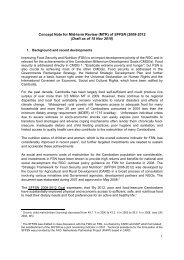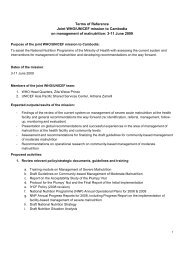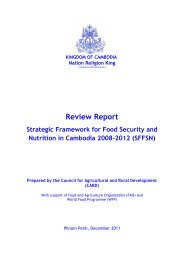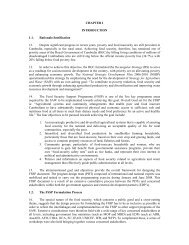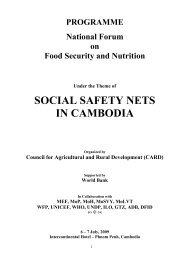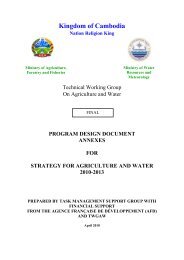Food Security and Nutrition in Cambodia: Pattern and ... - CDRI
Food Security and Nutrition in Cambodia: Pattern and ... - CDRI
Food Security and Nutrition in Cambodia: Pattern and ... - CDRI
You also want an ePaper? Increase the reach of your titles
YUMPU automatically turns print PDFs into web optimized ePapers that Google loves.
FAO (FSS 2010), <strong>and</strong> the Global Database of Child Growth <strong>and</strong> Malnutrition of the World Health<br />
Organization (WHO) (GDCGM 2010).<br />
3.1 The status quo <strong>in</strong> the context of regional development<br />
<strong>Cambodia</strong> is a low-<strong>in</strong>come country with an average per capita <strong>in</strong>come of US$500 <strong>in</strong> 2008. Among<br />
the countries compared <strong>in</strong> this study, only Lao PDR <strong>and</strong> Bangladesh have lower per capita <strong>in</strong>come<br />
levels. While 2008 per capita <strong>in</strong>come <strong>in</strong> Vietnam <strong>and</strong> India is modestly higher, per capita <strong>in</strong>come<br />
<strong>in</strong> Ch<strong>in</strong>a <strong>and</strong> Thail<strong>and</strong> is respectively four <strong>and</strong> five times that of <strong>Cambodia</strong> (Table 1, first panel <strong>and</strong><br />
first column). Table 1 also reports the year <strong>in</strong> which each of the compared countries last had <strong>in</strong>come<br />
levels on par with <strong>Cambodia</strong>’s today. India <strong>and</strong> Vietnam reached <strong>Cambodia</strong>’s current <strong>in</strong>come level<br />
only a few years earlier, as per capita <strong>in</strong>come is comparable between India <strong>in</strong> 2003, Vietnam <strong>in</strong><br />
2004, <strong>and</strong> <strong>Cambodia</strong> <strong>in</strong> 2008. On the other h<strong>and</strong>, Ch<strong>in</strong>a <strong>and</strong> Thail<strong>and</strong> reached per capital <strong>in</strong>come<br />
level of US$500 <strong>in</strong> 1993 <strong>and</strong> 1970, respectively (Table 1, first panel <strong>and</strong> second column).<br />
The agricultural sector still plays a major role <strong>in</strong> <strong>Cambodia</strong>’s economy, account<strong>in</strong>g for 35% of GDP.<br />
Agriculture has a similar share of GDP <strong>in</strong> Lao PDR as does <strong>Cambodia</strong>, while agricultural share of<br />
GDP is low <strong>in</strong> all other countries, <strong>in</strong>clud<strong>in</strong>g Bangladesh, where per capita <strong>in</strong>come is lower than that<br />
<strong>in</strong> <strong>Cambodia</strong> at the present (Table 1, first panel <strong>and</strong> third column).<br />
Literacy rate among female adults is an important social development <strong>in</strong>dicator, <strong>and</strong> it is also<br />
important for child feed<strong>in</strong>g practices <strong>and</strong> hence for improv<strong>in</strong>g child nutrition <strong>and</strong> health (Guldan<br />
et al. 1993). Thus, we consider this <strong>in</strong>dicator <strong>in</strong> the comparison. As shown <strong>in</strong> the second panel of<br />
Table 1, <strong>in</strong> <strong>Cambodia</strong>, about 70% of all females aged 15 years <strong>and</strong> older are literate. While this rate<br />
is comparable with Lao PDR, it is considerably higher than <strong>in</strong> Bangladesh <strong>and</strong> India. As expected, a<br />
much higher rate of female literacy is observed <strong>in</strong> Ch<strong>in</strong>a <strong>and</strong> Vietnam as well as <strong>in</strong> Thail<strong>and</strong>.<br />
Poverty <strong>and</strong> hunger (or undernourishment) still affect more than one-fourth of <strong>Cambodia</strong>ns<br />
today. Nonetheless, poverty is about half as prevalent as <strong>in</strong> Bangladesh <strong>and</strong> about two-thirds as<br />
prevalent as <strong>in</strong> India <strong>and</strong> Lao PDR. However, <strong>in</strong> contrast to the poverty patterns, the prevalence of<br />
undernourishment (hunger) <strong>in</strong> <strong>Cambodia</strong>, that is, the percentage of people consum<strong>in</strong>g less than<br />
the m<strong>in</strong>imum requirement of calories, is almost the same as that <strong>in</strong> Bangladesh <strong>and</strong> only slightly<br />
higher than that <strong>in</strong> India. On the other h<strong>and</strong>, the prevalence of undernourishment is lower <strong>in</strong> Lao<br />
PDR than <strong>in</strong> <strong>Cambodia</strong>, although Lao PDR has a higher level of poverty <strong>and</strong> lower level of per capita<br />
<strong>in</strong>come than <strong>Cambodia</strong> does.<br />
Three anthropometric <strong>in</strong>dicators are used to measure the status of child malnutrition 1 . As reported<br />
<strong>in</strong> the third panel of Table 1 <strong>and</strong> consistent with the <strong>in</strong>come level, child malnutrition <strong>in</strong> <strong>Cambodia</strong> is<br />
higher than that <strong>in</strong> Vietnam, Ch<strong>in</strong>a <strong>and</strong> Thail<strong>and</strong>, but is less widespread than <strong>in</strong> Lao PDR, Bangladesh<br />
<strong>and</strong> India. However, the mortality rate among <strong>Cambodia</strong>n children younger than 5 years is the<br />
highest among the compared countries.<br />
Taken together, the <strong>in</strong>dicators suggests that <strong>Cambodia</strong>’s stage of development <strong>and</strong> food security<br />
situation is similar to that of Lao PDR <strong>and</strong> Bangladesh today, Vietnam at the beg<strong>in</strong>n<strong>in</strong>g of the 2000,<br />
<strong>and</strong> Thail<strong>and</strong> <strong>in</strong> the late 1970s. The situation <strong>in</strong> India at the present <strong>and</strong> <strong>in</strong> the past somehow<br />
1 These <strong>in</strong>dicators are height-for-age, weight-for-height, <strong>and</strong> weight-for-age. Children are considered as<br />
moderately <strong>and</strong> severely underweight, stunted, or wasted, if their weight-for-age z-scores (WAZ), heightfor-age<br />
z-scores (HAZ), or weight-for-height z-scores (WHZ) are below certa<strong>in</strong> critical values. These<br />
three <strong>in</strong>dicators have different implications for child nutrition <strong>and</strong> cannot be used <strong>in</strong>terchangeably<br />
(WHO 1995).<br />
8 A Policy Discussion Paper



